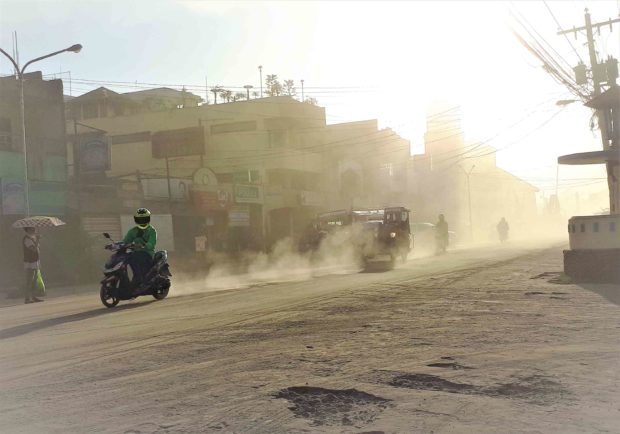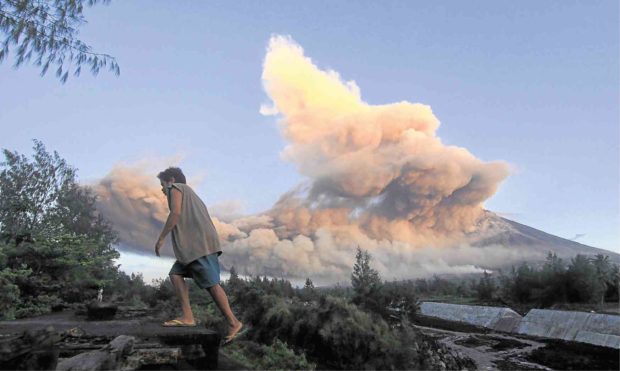Mayon evacuees rise to 60,000

ROAD HAZARD Motorists drive with difficulty along the ash-covered streets of Guinobatan and other towns in Albay province as Mt. Mayon showers them with ash in a series of eruptions. —MICHAEL B. JAUCIAN
LEGAZPI CITY — The number of evacuees fleeing the eruption of Mount Mayon soared to more than 60,000 on Wednesday after authorities extended the danger zone around the country’s most active and picturesque volcano.
Evacuations began on Jan. 13 when Mayon started to be rocked by a series of eruptions that sent ash clouds several kilometers into the sky, followed by lava fountains and pyroclastic flows.
The Philippine Institute of Volcanology and Seismology (Phivolcs) on Monday raised the alert at the volcano to Level 4, meaning that hazardous eruptions could occur within hours or days.
On Tuesday, authorities extended the 6-kilometer danger zone to 8 km, plus another kilometer for preemptive evacuation, triggering a spike in the number of people fleeing to temporary shelters.
The Albay Public Safety and Emergency Management Office on Wednesday reported 15,468 families or 60, 564 people, had been evacuated.
Article continues after this advertisementLava fountains
Article continues after this advertisementPhivolcs reported five more “intense but sporadic lava fountaining” from Mayon’s crater over a 19-hour period from Tuesday morning.
Its resident volcanologist, Eduardo Laguerta, said the eruptions, occurring in four- to five-hour intervals, could signify that Mayon was at the “peak” of its eruptive stage or the volcano was gathering more strength.
Lava fountains 500-600 meters high lasted between seven minutes and more than an hour and generated ash plumes 3-5 km above the crater, Phivolcs said.
Schools were shut in 17 cities and municipalities in Albay and nearby Camarines Sur province, which was also affected by ashfall. Fifty-six flights to and from the region had been canceled.
Laguerta said ash and other debris spewed by the volcano could produce a huge volume of lahar that moderate to heavy rains could mobilize down from the volcano’s gullies to river channels on the west side of Mayon.
The volcano has so far ejected around 6.2 million cubic meters of molten rock or lava, Laguerta said, though he had no immediate estimate of the amount of possible new lahar materials from the ash plumes and pyroclastic flows— clouds of deadly superheated gas and volcanic debris that roll down Mayon’s flanks at high speed.

MAYON HIDES BEHIND ASH CLOUD A resident of Daraga town in Albay province takes an early morning walk as an ash cloud covers the picturesque Mt. Mayon. This photo was taken at 6:20 a.m. on Wednesday from Barangay Busay in Daraga. —GEORGE GIO BRONDIAL
Lahar threat
He said the layer of “sandy” deposit on Mayon’s slopes was being closely monitored.
The lahar-threatened villages are Miisi and Salvacion in Daraga, Anoling in Camalig, Maninila and Masarawag in Guinobatan, and Buyoan in Legazpi. Except for Buyoan, these areas are within the 6-km permanent danger zone.
At the shelters, people slept on the floor and each shared a single toilet with dozens of other people, the Philippine Red Cross said.
Mostly farmers and their families, the evacuees were surviving on food handouts from the government and charities, with the Red Cross pitching in with drinking water, counseling and hygiene items, Red Cross regional administrator Rose Rivero told the French news agency Agence France-Presse (AFP).
Arnel Garcia, regional director of the Department of Social Welfare and Development, said the agency had distributed P17.1 million worth of relief goods to the evacuees in 58 evacuation centers.
The government would need P492 million to support 20,000 evacuees for 100 days, Garcia said.
Presidential spokesperson Harry Roque said the Department of Budget and Management has released the internal revenue allotment for Albay and the local governments in the province can start tapping their 5-percent contingency fund.
Foreign tourists
Mayon’s eruptions are drawing curious American, European and South Korean tourists, local hoteliers said.
“They are attracted by Mayon’s activity. They want to have a closer look,” Nics Ortonio, a receptionist at the packed four-star Oriental Hotel in Legazpi, told AFP.
“This is good for business, but as a resident, I am also affected,” said Ortonio, 22. She and her parents are staying put for now at their home.
Vice President Leni Robredo on Wednesday distributed relief goods at evacuation centers in Camalig and Guinobatan towns, and Ligao City where she met thousands of evacuees.
At Guinobatan East Central School, which houses 515 families (1,727 people) from Maninila village, Robredo spoke with Mayor Ann Ongjoco, who urged the government to put up a shelter to be used during calamities.
Ongjoco said classes were disrupted during evacuations because the schools were the only available emergency shelters in her town.
“Mayor Ongjoco is right,” Robredo said. “The government must invest in long-term solutions to problems like here in Guinobatan.” —With reports from Michael Jaucian, Juan Escandor Jr, Philip C. Tubeza, Rey Anthony Ostria, and the wires